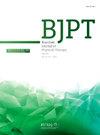The effectiveness of progressions of difficulty during an exercise program to improve balance and gait in older individuals: A randomized clinical trial
IF 3.2
3区 医学
Q1 ORTHOPEDICS
引用次数: 0
Abstract
Background
Little is discussed about the effectiveness and systematization of progressions of difficulty during balance exercises. Exercise progression provides continuous stimulation and assists physical therapists in offering challenges to patients.
Objective
To investigate the effectiveness of an exercise program with systematic progression of difficulty for older individuals.
Methods
Randomized clinical trial, with 22 older individuals allocated to experimental (EG, N = 12) or control (CG, N = 10) group. In EG, individuals performed an exercise program with progressions of difficulty for 12-weeks (2 days/week, 1 h/session). In the control group the participants performed the same program without progressions of difficulty. The Berg Balance Scale (BBS), Timed up and Go (TUG), and modified Dynamic Gait Index (mDGI) were assessed after and before the 24 exercise sessions. An intention-to-treat approach and multiple imputation by chained equations were utilized. Raw data were transformed into standardized individual differences (SID) and analyzed using one-way ANCOVA to test group effects, with baseline and age as covariates. A one-sample t-test was used to compare SIDs against zero. Effect sizes were estimated using partial eta squared (ηp²) and Cohen's d.
Results
ANCOVA revealed no significant group effect across any of the variables. Baseline values emerged as significant predictor of changes in BBS (P = 0.038, ηp²=0.219), TUG (P = 0.042, ηp²=0.210), and mDGI (P < 0.001, ηp²=0.545), suggesting a substantial differences among participants with lower baseline values. Age also emerged as a significant predictor of change for mDGI (P = 0.002, ηp²=0.431). Comparison with zero-value produced significant differences for BBS and mDGI, indicating increases in post-intervention for both groups.
Conclusion
Applying progressions of difficulty to the exercises, did not lead to greater improvements than not applying them.
Clinical trias
https://ensaiosclinicos.gov.br/rg/RBR-8dpxgcf
在改善老年人平衡和步态的锻炼计划中,难度递增的方法是否有效:随机临床试验
背景关于平衡练习中难度递增的有效性和系统性的讨论很少。方法随机临床试验,22 名老年人被分配到实验组(EG,12 人)或对照组(CG,10 人)。在 EG 组,参与者进行为期 12 周(每周 2 天,每节课 1 小时)的难度递增锻炼计划。在对照组中,参与者进行的是相同的项目,没有难度递增。在 24 次锻炼之后和之前,分别对 Berg 平衡量表(BBS)、定时起立行走(TUG)和改良动态步态指数(mDGI)进行了评估。采用意向治疗法和连锁方程多重归因法。原始数据被转换为标准化个体差异(SID),并使用单因子方差分析来检验组间效应,基线和年龄作为协变量。单样本 t 检验用于比较 SID 与零的差异。使用偏等平方(ηp²)和 Cohen's d 估算效应大小。结果ANCOVA 显示,任何变量都没有显著的群体效应。基线值是预测 BBS(P = 0.038,ηp²=0.219)、TUG(P = 0.042,ηp²=0.210)和 mDGI(P < 0.001,ηp²=0.545)变化的重要因素,表明基线值较低的参与者之间存在很大差异。年龄也是预测 mDGI 变化的一个重要因素(P = 0.002,ηp²=0.431)。BBS 和 mDGI 与零值的比较产生了显著差异,表明两组干预后均有所提高。结论在练习中应用难度递增并不比不应用难度递增带来更大的改善。临床三https://ensaiosclinicos.gov.br/rg/RBR-8dpxgcf。
本文章由计算机程序翻译,如有差异,请以英文原文为准。
求助全文
约1分钟内获得全文
求助全文
来源期刊
CiteScore
6.10
自引率
8.80%
发文量
53
审稿时长
74 days
期刊介绍:
The Brazilian Journal of Physical Therapy (BJPT) is the official publication of the Brazilian Society of Physical Therapy Research and Graduate Studies (ABRAPG-Ft). It publishes original research articles on topics related to the areas of physical therapy and rehabilitation sciences, including clinical, basic or applied studies on the assessment, prevention, and treatment of movement disorders.

 求助内容:
求助内容: 应助结果提醒方式:
应助结果提醒方式:


